|
Dana and I just returned from a long, arduous
and wonderful trek to the Upper Arun River Valley in Nepal
where the Medicinal and Aromatic Plants project you have supported
is flourishing. (photo #1) 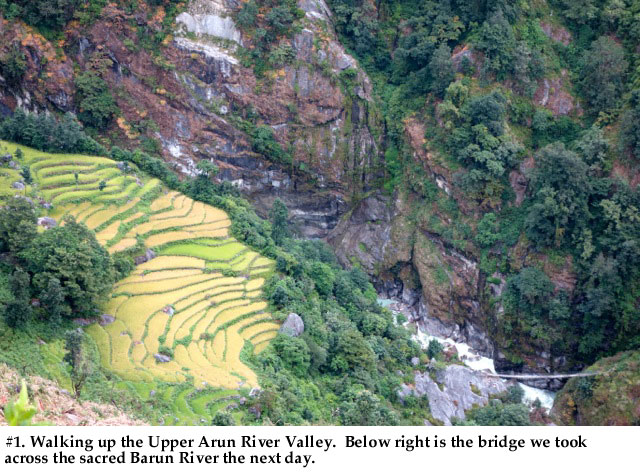 The area
is so steep and isolated that in 10 days walking up the valley
in a place where everyone farms, we saw neither a road nor
a single wheeled implement, not even a wheelbarrow.
(photo #2) The area
is so steep and isolated that in 10 days walking up the valley
in a place where everyone farms, we saw neither a road nor
a single wheeled implement, not even a wheelbarrow.
(photo #2) 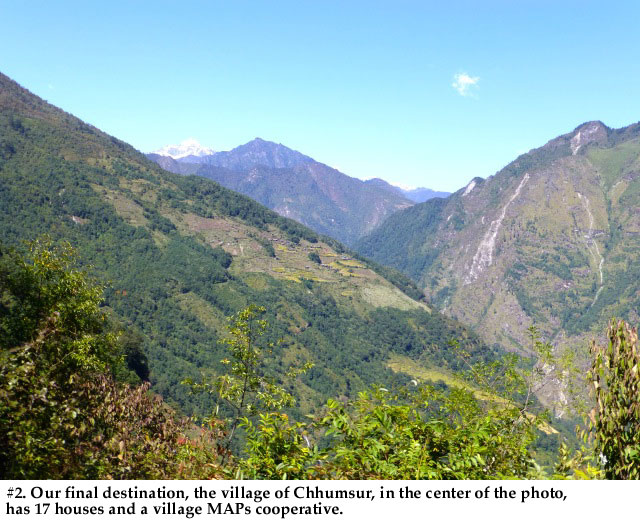 We were amazed
to see how in the short time of 5 or 6 years, the MAPs project
has become an integral part of and support for the
ancient Tibetan culture of the Upper Arun. Of the 2,400
Bhotia households in the villages in the area, 1,900 are
now cultivating MAPs plants and selling them across
the nearby border in Tibet. We were amazed
to see how in the short time of 5 or 6 years, the MAPs project
has become an integral part of and support for the
ancient Tibetan culture of the Upper Arun. Of the 2,400
Bhotia households in the villages in the area, 1,900 are
now cultivating MAPs plants and selling them across
the nearby border in Tibet.
We visited eight
of the villages engaged in MAPs cultivation and talked to many of
the women and men involved in MAPs farming. We were impressed
by the enthusiasm and commitment everyone has for the program.
Some villages have 100% participation. We walked with
Karma, whom we supported in starting the Upper Arun MAPs
program 7 years ago, and with three Mountain Institute field
staff who work with the villagers to implement the program. They are
all from the Upper Arun and show an intense dedication,
sense of purpose and talent for the work they do. As
Jyabu commented, "Everyday I do social work."
Everywhere we went, the field staff was greeted with
warmth and appreciation.
In Chyamtang (photo
#3) we were happy to see Goba Jamyang Bhotia and his wife Chhijik,
whom we knew from our previous visit. (photo #4). 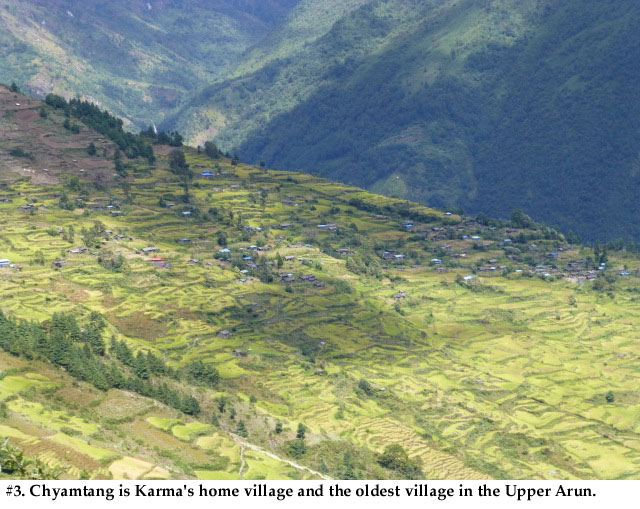 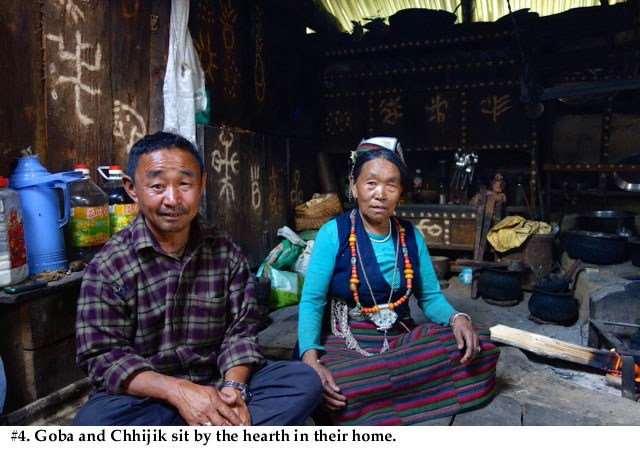 They work together cultivating about
12 acre of Chiraito (Swertiya chiraita). Previously,
Goba was sometimes a porter and sometimes a farmer. Now,
with MAPs income, he can stay at home and just farm - both MAPs
and traditional crops. Last year they made enough money
from MAPs sales to help pay for replacing their old bamboo
mat roof with a new blue metal roof (photo #5). They work together cultivating about
12 acre of Chiraito (Swertiya chiraita). Previously,
Goba was sometimes a porter and sometimes a farmer. Now,
with MAPs income, he can stay at home and just farm - both MAPs
and traditional crops. Last year they made enough money
from MAPs sales to help pay for replacing their old bamboo
mat roof with a new blue metal roof (photo #5).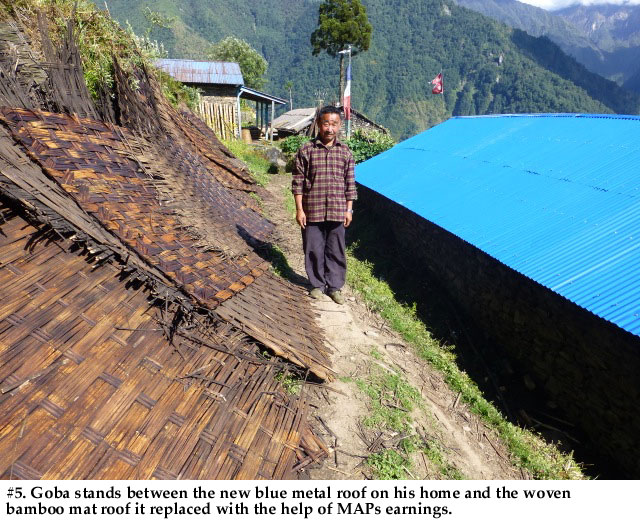 With the new roof in place, they intend
to use their MAPs income to help send their grandchildren
to the new private boarding school in nearby Lingam.
The boarding school, a step up from the neighboring free government
school, was started by two young entrepreneurs who likely saw
an opportunity created by the new source of income
to pay for better education. With the new roof in place, they intend
to use their MAPs income to help send their grandchildren
to the new private boarding school in nearby Lingam.
The boarding school, a step up from the neighboring free government
school, was started by two young entrepreneurs who likely saw
an opportunity created by the new source of income
to pay for better education.
Goba bought 500
grams of Chiraito seeds for next year and is already becoming self-sufficient
as a Chiraito farmer. Now he wants help learning to grow Satuwa (Paris
polyphylla), a higher cash value MAPs product. Goba
is 58. He says that as he gets older he will still
be able to farm MAPs because they are less labor intensive and vulnerable.
When asked why the MAPs program is important, Goba made
an important observation about the value of the MAPs
project to the community: "Everyone is cultivating
MAPs, not just the rich people, so everyone is doing better."
In Hungung we
stood in a harvested cornfield and talked to Phupu Bhotia.
Along with her family, she cultivates Chiraito, but is
most proud of the 500 hundred high value Satuwa plants
she is growing in a steep, shaded
gulley behind her house. (photo #6)
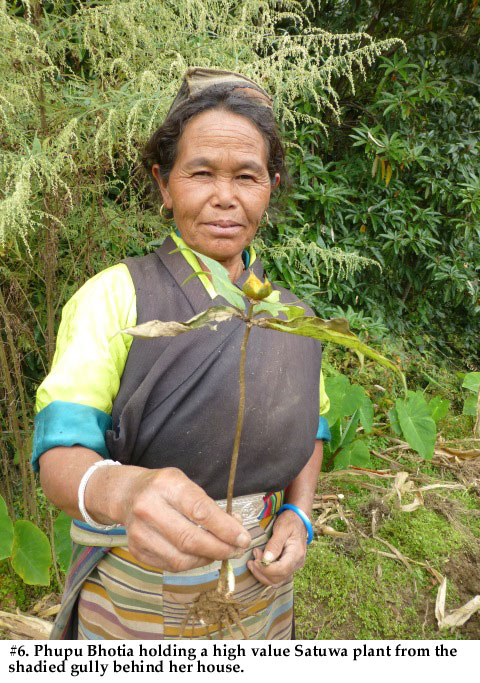
When asked what she would do with her MAPs earnings, Phupu
said that she would use the money for household expenses
and her children's education. She has 5 sons and 3 daughters.
Several years ago they were having financial problems and could not
afford food and education for all of the children. And
so, they got a lama to take away two of the boys, aged 6
and 10, to study to be lamas in India. If the MAPs program
had come earlier, perhaps Phupu could have kept her family
together.
In Syaksila we
went to a house, part of which is a cave. In the cave next to
the cooking fire we met 19-year-old, just married Yazung Bhotia.
(photo #7) 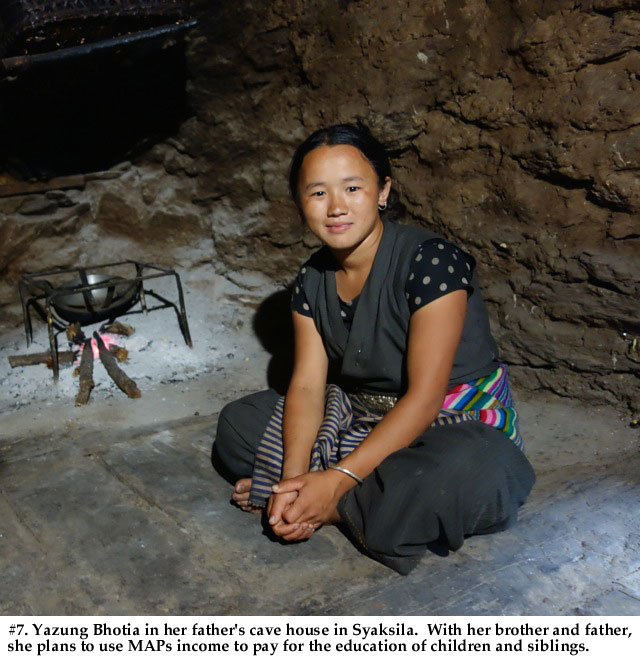 Yazung belongs
to a women's group that grows MAPs crops as an informal cooperative.
In addition, she grows Chiraito with her family, including her
27-year-old brother Mikma Tenzing Bhotia who has 3 children.
Next year they will have their first harvest. They
want to invest their earnings in the education of their
children and of younger brother and sister. "Maybe
someone will go to Kathmandu and study to be a teacher or a
doctor." Yazung belongs
to a women's group that grows MAPs crops as an informal cooperative.
In addition, she grows Chiraito with her family, including her
27-year-old brother Mikma Tenzing Bhotia who has 3 children.
Next year they will have their first harvest. They
want to invest their earnings in the education of their
children and of younger brother and sister. "Maybe
someone will go to Kathmandu and study to be a teacher or a
doctor."
Cherjik Ma Bhotia
is the president of a women's group in Chepuwa that also grows
Chiraito. (photo #8) 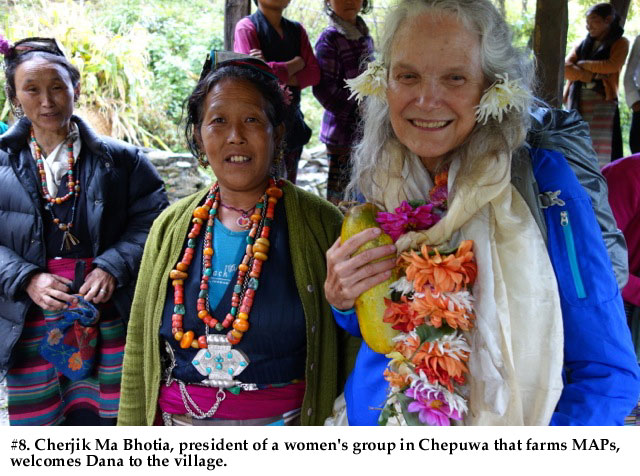 Last year
they earned $290 and expect to earn $500 next year.
Borrowing money in Nepal is exorbitant; any location to even
consider borrowing money is several days walk for Chepuwa. The
women's group lends its earnings to members at 1% interest.
Incidentally, Cherjik Ma's women's group has 27 women and
9 men. Last year
they earned $290 and expect to earn $500 next year.
Borrowing money in Nepal is exorbitant; any location to even
consider borrowing money is several days walk for Chepuwa. The
women's group lends its earnings to members at 1% interest.
Incidentally, Cherjik Ma's women's group has 27 women and
9 men.
Entering the program
nearly 5 years ago, Dawa Nuppu Lama of Chyamtang, was one of
the first MAPs farmers. (photo #9) 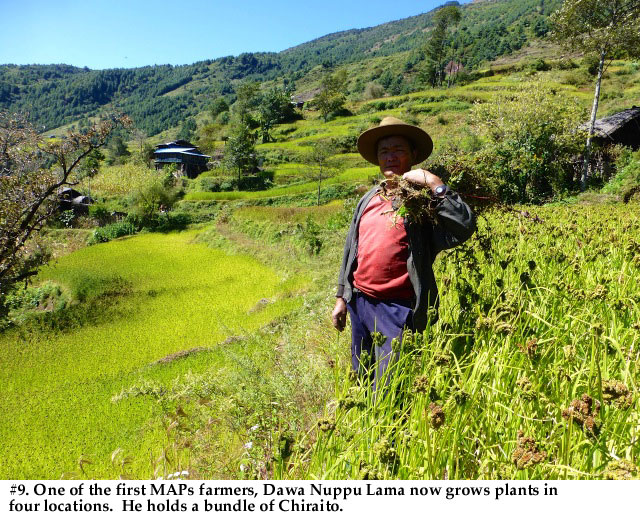 He
recognizes the value of the program to the community
and the importance of the fact that the plants can be grown
in places not suitable for traditional crops retaining
walls that create terraces for rice and millet, shaded
gullies, and exhausted old steep-slope slash and burn fields.
(photos #10 and 11) He
recognizes the value of the program to the community
and the importance of the fact that the plants can be grown
in places not suitable for traditional crops retaining
walls that create terraces for rice and millet, shaded
gullies, and exhausted old steep-slope slash and burn fields.
(photos #10 and 11) 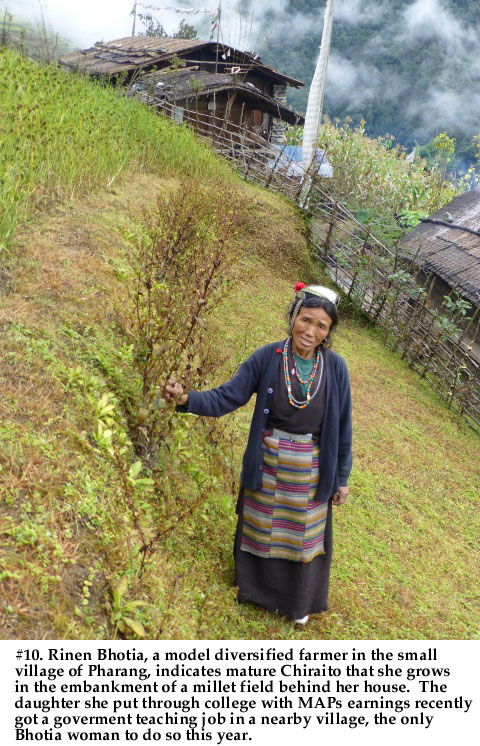
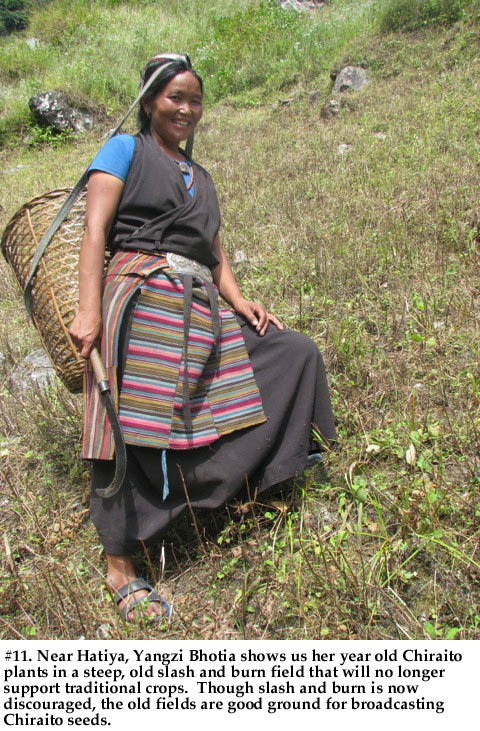
(MAPs training successfully discourages new slash and burn
agriculture.) "MAPs cultivation is good for the
whole community because it gives everyone a chance to earn money.
It allows us to use land that otherwise would be of no
use." Dawa has grown cardamom, potatoes,
millet, etc. - "It is all expensive to plant and you
have to deal with weather and disease, and with animals like
deer, pika and sometimes bear. Deer don't eat Chiraito."
Scattered over
952 rugged square km of the Upper Arun, the Bhotia villages constitute
what might be called a supplemented sustainable community. The lifestyle
is sustainable subsistence farming but the land does not
produce enough to subsist on, to provide food security in
the event of crop damage or the income to acquire better education,
health care and amenities such as metal roofs, reliable
water sources and efficient, vented cook stoves. To earn supplemental
income, some villagers, particularly men, have traditionally
left the Upper Arun to become porters (essentially human
mules) or find jobs in Kathmandu or abroad. This may
result in jobs left undone on the farm, absentee fathers,
or elderly parents without adequate family support and an erosion
of social cohesion.
As Karma put it:
"As the population grows, the economy needs to be supplemented.
To supplement, people have had to leave, to go elsewhere
to work, to carry good on their backs. When people
leave, they don't do the work in the village and in the
fields. Carrying goods on the trail is one way to
get extra income, but Chiraito helps people stay in the
village to be with children and each other. Maybe
it will help keep the fabric of the community from unraveling."
As MAPs crops
are maturing and more and more land unsuited for traditional crops
is being planted, the MAPs project is beginning to interrupt
this pattern of needing to leave the Upper Arun to
supplement income. As a widely shared activity, MAPs
cultivation is being woven into the community culture, and
as a source of supplemental income, it is helping to strengthen
and stabilize that culture. At the end of a long evening
discussion with MAPs farmers in Syaksila, one man summed
it up when he said that the MAPs program is "a
way to solidify culture and community."
How will the MAPS program affect the present
and the future of Bhotia culture in the Upper Arun River Valley?
(photos #12-15)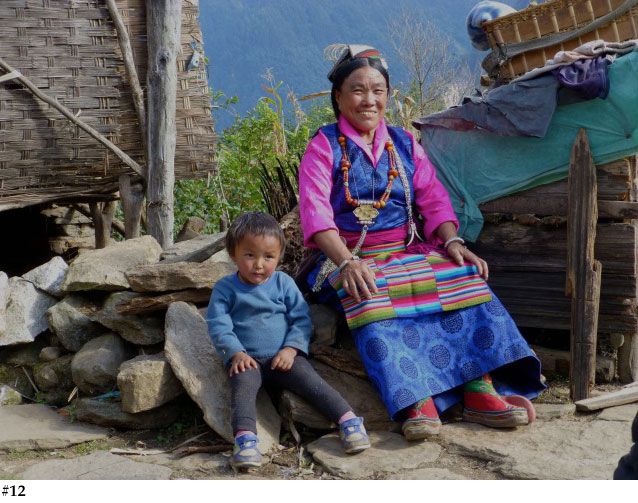 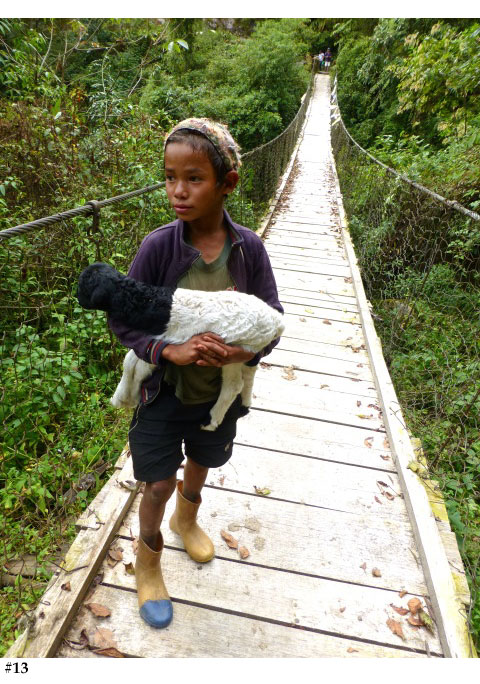 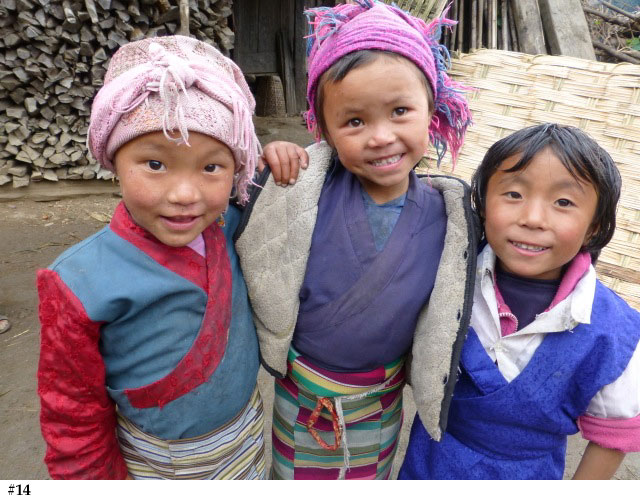 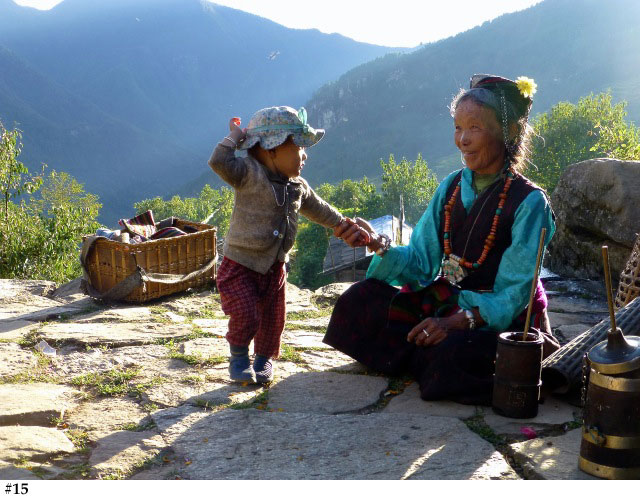
What needs to
be done in the next two years? 1. Extend MAPs opportunities to
small, difficult to access villages not currently participating
in the program. 2. Establish marking strategy and infrastructure
that will increase to farmers a higher percentage return
of the ultimate value of the product they are producing.
3. Help establish cooperatives and shared facilities
to increase efficiency and market power. 4. Expand the variety
of MAPs species under cultivation, particularly high value
species. 5. Continue refresher training and support
for MAPs farmers, especially those who have recently begun the
program, and provide additional trainings for the field staff.
Please let me know if you have questons about this wonderful
project. If you are interested in supporting the Upper Arun MAP
Project, please contact Rand Jack at randfjack@gmail.com
|
 The area
is so steep and isolated that in 10 days walking up the valley
in a place where everyone farms, we saw neither a road nor
a single wheeled implement, not even a wheelbarrow.
(photo #2)
The area
is so steep and isolated that in 10 days walking up the valley
in a place where everyone farms, we saw neither a road nor
a single wheeled implement, not even a wheelbarrow.
(photo #2)  We were amazed
to see how in the short time of 5 or 6 years, the MAPs project
has become an integral part of and support for the
ancient Tibetan culture of the Upper Arun. Of the 2,400
Bhotia households in the villages in the area, 1,900 are
now cultivating MAPs plants and selling them across
the nearby border in Tibet.
We were amazed
to see how in the short time of 5 or 6 years, the MAPs project
has become an integral part of and support for the
ancient Tibetan culture of the Upper Arun. Of the 2,400
Bhotia households in the villages in the area, 1,900 are
now cultivating MAPs plants and selling them across
the nearby border in Tibet.
 They work together cultivating about
12 acre of Chiraito (Swertiya chiraita). Previously,
Goba was sometimes a porter and sometimes a farmer. Now,
with MAPs income, he can stay at home and just farm - both MAPs
and traditional crops. Last year they made enough money
from MAPs sales to help pay for replacing their old bamboo
mat roof with a new blue metal roof (photo #5).
They work together cultivating about
12 acre of Chiraito (Swertiya chiraita). Previously,
Goba was sometimes a porter and sometimes a farmer. Now,
with MAPs income, he can stay at home and just farm - both MAPs
and traditional crops. Last year they made enough money
from MAPs sales to help pay for replacing their old bamboo
mat roof with a new blue metal roof (photo #5). With the new roof in place, they intend
to use their MAPs income to help send their grandchildren
to the new private boarding school in nearby Lingam.
The boarding school, a step up from the neighboring free government
school, was started by two young entrepreneurs who likely saw
an opportunity created by the new source of income
to pay for better education.
With the new roof in place, they intend
to use their MAPs income to help send their grandchildren
to the new private boarding school in nearby Lingam.
The boarding school, a step up from the neighboring free government
school, was started by two young entrepreneurs who likely saw
an opportunity created by the new source of income
to pay for better education.
 Yazung belongs
to a women's group that grows MAPs crops as an informal cooperative.
In addition, she grows Chiraito with her family, including her
27-year-old brother Mikma Tenzing Bhotia who has 3 children.
Next year they will have their first harvest. They
want to invest their earnings in the education of their
children and of younger brother and sister. "Maybe
someone will go to Kathmandu and study to be a teacher or a
doctor."
Yazung belongs
to a women's group that grows MAPs crops as an informal cooperative.
In addition, she grows Chiraito with her family, including her
27-year-old brother Mikma Tenzing Bhotia who has 3 children.
Next year they will have their first harvest. They
want to invest their earnings in the education of their
children and of younger brother and sister. "Maybe
someone will go to Kathmandu and study to be a teacher or a
doctor." Last year
they earned $290 and expect to earn $500 next year.
Borrowing money in Nepal is exorbitant; any location to even
consider borrowing money is several days walk for Chepuwa. The
women's group lends its earnings to members at 1% interest.
Incidentally, Cherjik Ma's women's group has 27 women and
9 men.
Last year
they earned $290 and expect to earn $500 next year.
Borrowing money in Nepal is exorbitant; any location to even
consider borrowing money is several days walk for Chepuwa. The
women's group lends its earnings to members at 1% interest.
Incidentally, Cherjik Ma's women's group has 27 women and
9 men. He
recognizes the value of the program to the community
and the importance of the fact that the plants can be grown
in places not suitable for traditional crops retaining
walls that create terraces for rice and millet, shaded
gullies, and exhausted old steep-slope slash and burn fields.
(photos #10 and 11)
He
recognizes the value of the program to the community
and the importance of the fact that the plants can be grown
in places not suitable for traditional crops retaining
walls that create terraces for rice and millet, shaded
gullies, and exhausted old steep-slope slash and burn fields.
(photos #10 and 11) 




